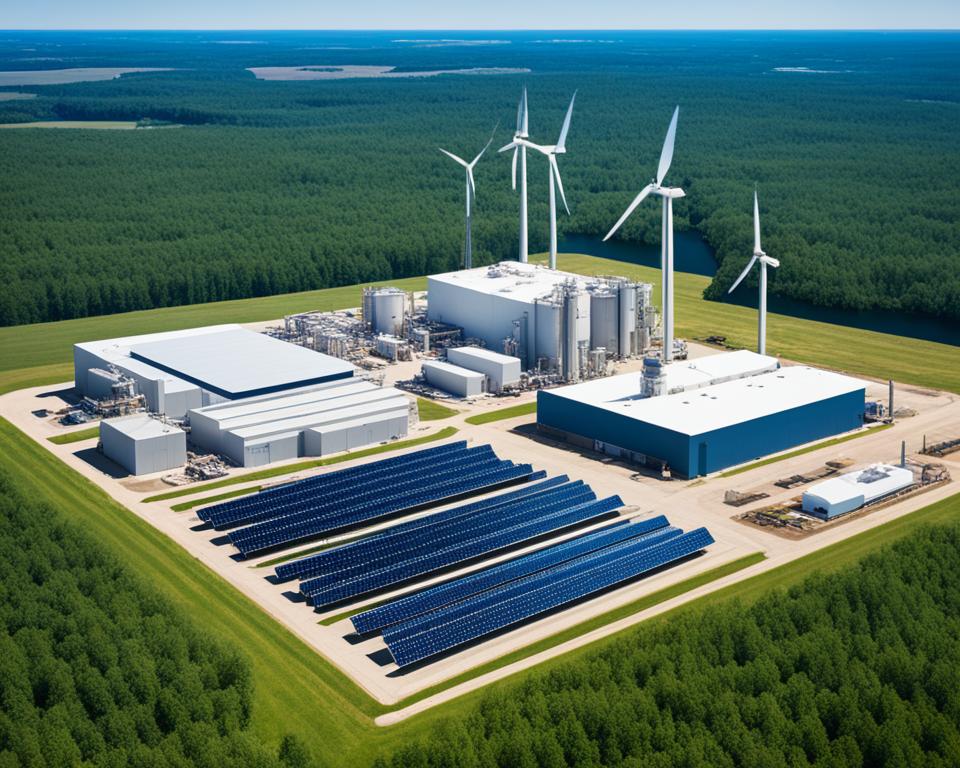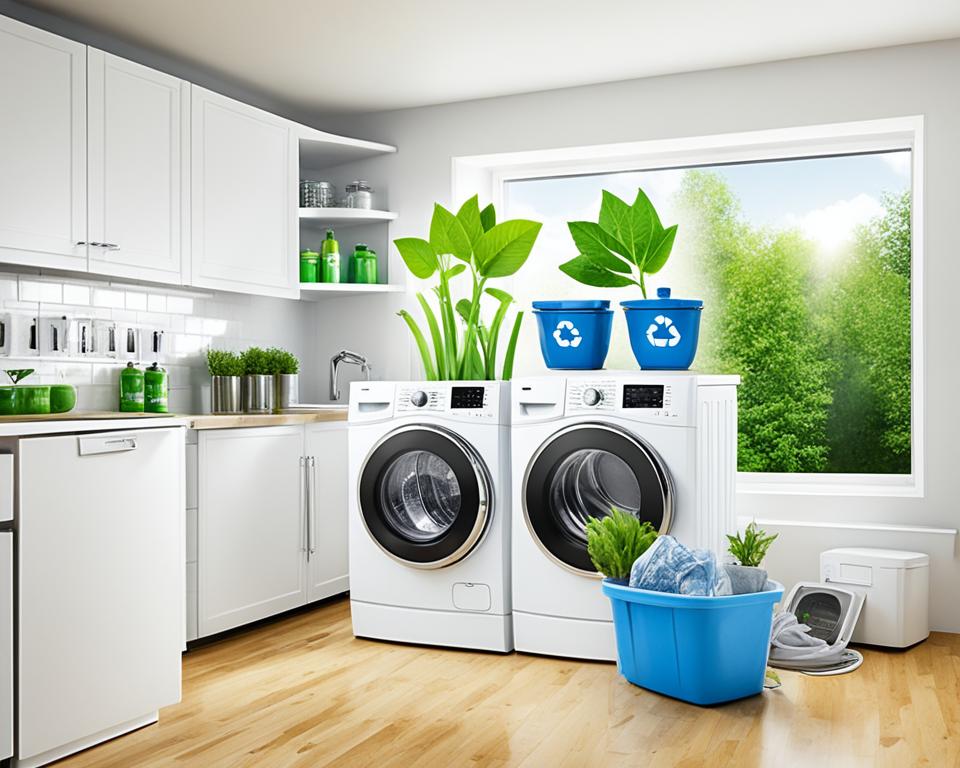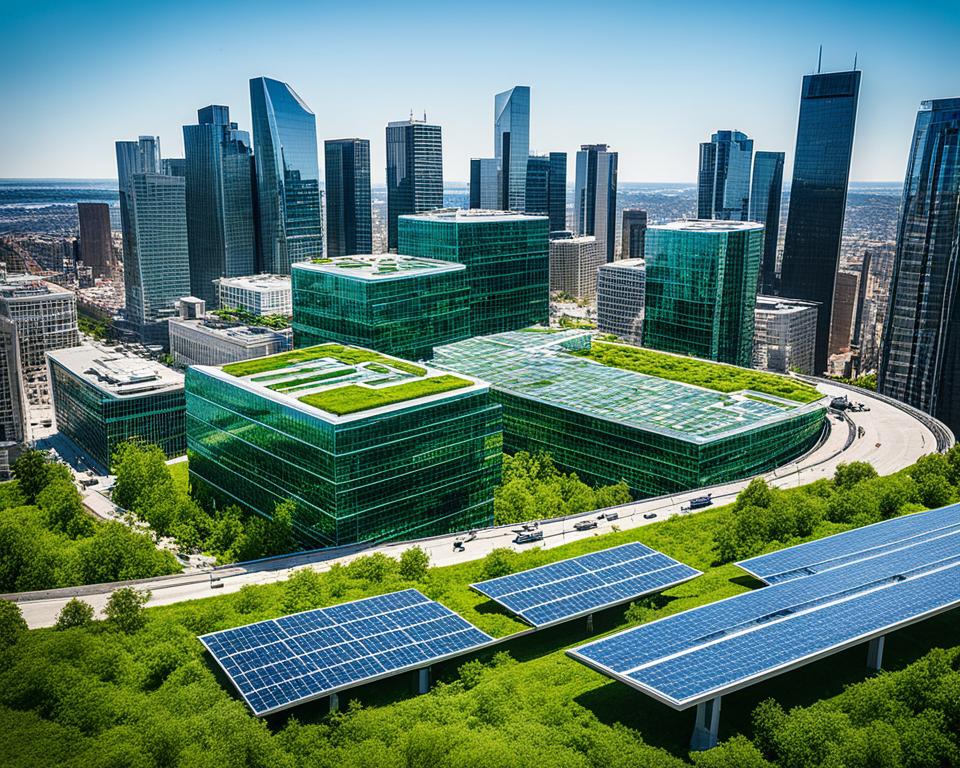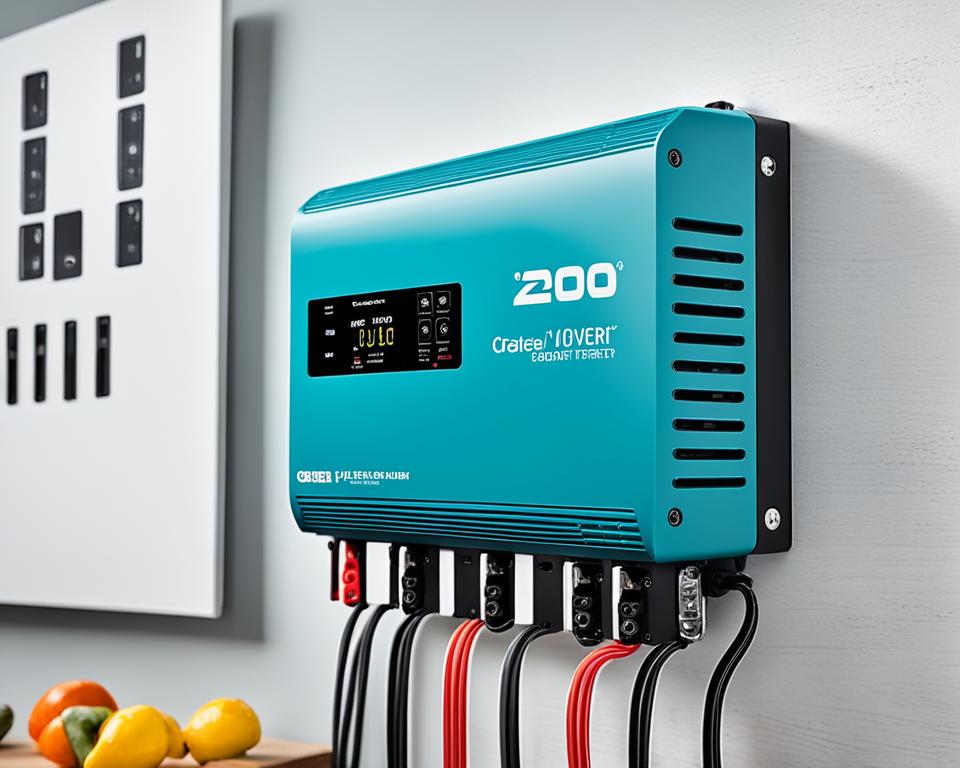In today’s world, we face many environmental challenges. Environmentally friendly technology is becoming essential for the future. This article looks at the latest innovations, clean energy advances, and eco-friendly solutions driving towards a greener planet.
From renewable energy sources to sustainable building materials, we explore it all. Also, smart city infrastructure and nature-based climate solutions play a big part. You will see how these new technologies are changing industries and our lives. They are also cutting down on carbon footprints for a better future.
Read interesting things at : climbing-gym-oz
Key Takeaways
- Environmentally friendly technology is a driving force behind sustainability, shaping a greener future.
- This article explores cutting-edge innovations in clean energy, eco-friendly solutions, and smart city infrastructure.
- Renewable energy sources, sustainable building materials, and nature-based climate solutions are transforming industries.
- Innovative technologies are reducing carbon footprints and paving the way for a more sustainable tomorrow.
- The article provides an in-depth look at the transformative potential of green technology.
What is Environmentally Friendly Technology?
In today’s world, everyone is more aware of the environment. This is where “environmentally friendly technology” comes in. They are often called “green tech.” This technology aims to lessen or stop harm to the planet. It focuses on using resources wisely and being kind to the environment.
Defining Green Tech
Green tech isn’t just a fancy term. It’s a real effort to fix our planet. It includes many new ideas. For example, making energy from the sun, better ways to use power, products that hurt the earth less, and ways to move around that are gentle on the environment. All these things help lower greenhouse gases, save nature, and reduce how much humans hurt the earth.
The Need for Sustainable Innovations
There is a big need for new, green ideas. Why? Because the earth is facing serious problems like climate change, using up resources, and pollution. The world is growing, and more things are being made. So, we need new ways to use energy and materials that won’t hurt the earth. That’s where green tech comes in. It promises a future where we can grow while taking good care of the planet and people.
The Rise of Clean Energy Technology
The world is tackling big environmental problems by pushing for clean energy. Clean energy technology, like solar power and wind energy, is changing our future for the better. Let’s explore the huge progress in these renewable energy sources.
Solar Power Advancements
In the last few years, solar power has changed a lot. The costs have gone down and the tech has gotten better. Now, solar panels can catch much more of the sun’s power and turn it into electricity. This makes clean energy technology a top choice for more people, including homeowners and businesses.
Good government rules and help have also boosted the use of solar power. More people and groups are switching to solar energy. This helps cut down on harmful gases and lets communities use their own renewable technology.
Wind Energy Innovations
Wind energy has also seen great improvements. Engineers have made wind turbines better at making power. By placing them in windy spots, wind energy is now a strong option for many. This is helping communities and businesses go green.
In the sea, offshore wind farms are growing. They use strong, steady sea winds to make energy. Lots of money from both the government and companies is going into this. They see a big chance to fight climate change with the power of the wind.
The growth of solar power and wind energy shows us how important renewable technology is. More and more, we see these changes as key to a future we can breathe easy in. Governments, businesses, and people are choosing these new, green ways. Together, we’re on a clear path to a better, more sustainable tomorrow.
Eco-Friendly Solutions for Transportation
The world is looking for ways to reduce greenhouse gas emissions. One big area is how we get around, like with cars and trucks. Now, there are new eco-friendly solutions that don’t make pollution. These include electric vehicles (EVs) and hydrogen fuel cell technology.
Electric Vehicles
Electric cars have become popular thanks to better batteries, more places to charge, and help from governments. They use electricity and don’t create harmful smoke. This makes them a cleaner choice for moving around. As technology gets better, driving an electric car is getting easier and more people are choosing them.
Hydrogen Fuel Cell Technology
Hydrogen cars are another cool idea for clean transportation. They work by mixing hydrogen and oxygen to make electricity. This powers the car without any pollution, just water comes out. They work a lot like regular cars but without making the air dirty. They’re great for big trucks and far trips too where regular electric cars might find it hard to go.
| Feature | Electric Vehicles | Hydrogen Fuel Cell Vehicles |
|---|---|---|
| Emissions | Zero direct tailpipe emissions | Zero direct tailpipe emissions |
| Refueling/Charging | Requires electrical charging infrastructure | Requires hydrogen refueling stations |
| Range | Improving battery technology enabling longer ranges | Comparable to traditional gasoline-powered vehicles |
| Cost | Higher upfront costs, but decreasing as technology advances | Higher upfront costs, but potential for cost parity with scale |
Sustainable Building and Construction
The building industry impacts the environment a lot. But now, it’s moving towards sustainable building practices. Today, we see green building materials like recycled plastics, bamboo, and cross-laminated timber. These materials are helping to make buildings less of a burden on the planet.
Green Building Materials
In construction, things are changing for the better. We’re using more eco-friendly solutions. Materials like recycled plastics, bamboo, and cross-laminated timber are getting more attention. They are long-lasting and good for the planet. Plus, they help cut down on waste and lock up carbon. This contributes to a circular economy.
Energy-Efficient Building Design
The building sector is now focusing on energy-efficient design too. It’s looking into things like passive solar architecture and smart HVAC systems. We’re also seeing more use of renewable energy sources. These changes are making structures use energy better. They are also making the air inside cleaner. This leads to more comfortable and greener spaces for work and living.
This shift to eco-friendly solutions brings lots of benefits. It helps with using less energy and producing fewer greenhouse gases. Plus, it makes where we live and work more comfy and healthy. The building sector is really making progress in sustainable building. Therefore, the future of our buildings looks promising. They will be both beautiful and good for the earth.
Renewable Technology for Water and Waste Management
In our journey towards a sustainable future, environmentally friendly technology plays a big role. It has hugely improved water management and waste management. Now, with renewable technology, we’re tackling issues like water shortage, pollution, and waste handling.
Take, for instance, renewable energy-powered desalination. These systems use the sun, wind, or heat from the earth to clean salt water. This process makes water that’s safe to drink. It stands out for being eco-friendly and using less energy than traditional ways.
Another major step is the development of wastewater treatment systems that recover resources. They take out useful stuff like nutrients, minerals, and even energy from the water. This creates a cycle where waste is made into something good again.
There are also advanced recycling and composting methods that are doing wonders. They help keep organic and recyclable materials out of the trash. This way, less gets buried in landfills, lessening our environmental impact.
| Renewable Technology Solution | Environmental Benefit |
|---|---|
| Renewable energy-powered desalination | Provides clean water while reducing energy-related environmental impact |
| Wastewater treatment with resource recovery | Transforms waste into valuable inputs, creating a circular economy |
| Advanced recycling and composting | Diverts waste from landfills, reducing environmental burden |
This renewable technology changes how we manage water and waste. It not only helps save natural resources but also builds a more eco-friendly world. This is how we’re working towards a future that can be sustained.
Low-Carbon Technologies in Manufacturing
The manufacturing sector is working hard to tackle its effect on the environment. It’s doing this by using low-carbon technologies. These include things like special systems to catch and store carbon and using renewable energy. Also, they’re finding ways to make things that use less energy and are more efficient.
Reducing Industrial Emissions
Manufacturers are focusing on carbon capture and storage (CCS) to lower pollution. This technology grabs carbon emissions to stop them from going into the air. It’s even better when used with clean energy, like from the sun and wind. Companies can then cut back on using oil and gas, moving towards greener ways.
Using energy-efficient methods is also a big deal for them. They’re coming up with new ways to make what they need without wasting energy. This includes things like better machinery, keeping it in good shape, and using smart computer programs. This helps them use less energy and make less trash while they work.
Circular Economy Principles
Manufacturers are also starting to follow the circular economy idea. This means they’re using their leftovers and waste again in their process. By doing this, they make less pollution and don’t use up as many resources. It’s a way that keeps materials going by reusing and finding other uses for them. It helps them work cleaner and smarter.
| Low-Carbon Technology | Emission Reduction Impact | Circular Economy Benefit |
|---|---|---|
| Carbon Capture and Storage (CCS) | Significant reduction in CO2 emissions | Supports the reuse of captured CO2 in various industrial processes |
| Renewable Energy Integration | Eliminates the need for fossil fuel-based energy sources | Enables a more sustainable and self-sufficient energy supply for manufacturing |
| Energy-Efficient Production | Reduces overall energy consumption and waste | Optimizes resource utilization and minimizes the environmental impact of manufacturing |
These moves towards using low-carbon technologies and circular economy ideas are big steps. They show the manufacturing world wants to be a leader in being sustainable and eco-friendly.

Nature-Based Solutions for Climate Change Mitigation
As the world faces climate change, we look for solutions in nature. These solutions, like planting trees, offer hope. They work to reduce the harm done by climate change.
Reforestation and Afforestation
Planting and growing trees help a lot. It can take in and store a lot of carbon dioxide. This gas warms the earth. Trees also help many plants and animals to have homes. This is why reforestation is getting more popular.
Green Infrastructure
Adding plants and natural areas in cities can help too. Green infrastructure does just that. It includes things like parks and green roofs. They can make cities cooler and cleaner. They also help manage water better.
Nature and technology are both important in fighting climate change. We need both to make a better future. Nature’s help is a key part of the plan. Together, we can do better.
Energy-Efficient Systems for Smart Cities
As the world grows more urban, smart cities lead in using eco-friendly tech. Energy-efficient systems are changing how cities use resources and manage their space.
Smart Grids
Smart cities rely on smart grids. These are advanced systems for electrical power. They use data, sensors, and controls to make the power grid more efficient and reliable.
Smart grids also include solar and wind power. This helps cities cut down on greenhouse gases and use more sustainable energy sources.
Intelligent Transportation Systems
Smart cities also need smart transportation. This includes advanced systems that manage traffic and connect vehicles to the road.
By making traffic flow better and encouraging green vehicles, these systems lower emissions and make cities more energy-efficient.
All these technologies work together with smart buildings and waste management. They’re creating urban areas that are truly eco-friendly and sustainable. By using data and green energy, smart cities are making the future of cities about saving resources and protecting our planet.
Environmentally Friendly Technology and Consumer Products
More and more people are looking for ways to better the environment. They are choosing products that are kind to our planet. This part talks about how consumer goods are catching up with this trend. It looks at how sustainable packaging and eco-friendly appliances are becoming more common.
Sustainable Packaging
Traditional packaging can harm the environment. But now, there’s a move toward using materials that are better for the earth. These include things like plant plastic, paper that’s been used before, and fibers that can break down. This shift helps to cut down on trash and lessen the harmful effects of making products. Also, using less packaging and making some products refillable is another step forward in being green.
Eco-Friendly Appliances
In our homes, we’re seeing more eco-friendly appliances than ever before. These include fridges and washers that use less power. There are also smart devices that help save water and electricity. By choosing these items, we’re all helping the environment. This is by using less energy, less water, and more recycled materials. So, every little change can move us towards a healthier planet.

Challenges and Barriers to Adoption
Environmentally friendly technology has vast potential. But, there are big challenges to its wide use. One challenge is the higher upfront costs of many green technologies. These costs can be too high for those with little money, like some individuals, businesses, and communities. This is why there’s a great need for better access to financing and investment options. These would help make sustainable solutions more popular.
The policy and regulatory frameworks are also key. They can help or hurt the use of these technologies. Governments must offer helpful incentives, guidelines, and standards to push forward the adoption of green solutions. Without these clear and supportive policies, sustainable innovations can be hard to advance. This could slow down their ability to deal with big environmental challenges.
Cost and Financing
The high upfront costs of green technologies create a big barrier to adoption. This includes renewable energy systems, eco-friendly building materials, and better transport. Overcoming this money issue needs new financing options and ways to invest. These could make green solutions more doable for everyone.
Policy and Regulatory Frameworks
How well we use green technology depends a lot on the policy and regulatory landscape. Governments do a lot by setting clear guidelines, incentives, and standards. They should promote the adoption of green solutions. Strong support from policy and regulatory frameworks is crucial. Otherwise, it’s hard for sustainable technologies to become common. They can’t have their full environmental impact.
The Role of Innovation and Research
Technological evolution is fueled by innovation and research. This area focuses on technological advancements that make green solutions more efficient, affordable, and scalable. It covers everything from new materials to how AI and machine learning are changing the game.
Technological Advancements
Scientists and engineers are pushing the boundaries to create green tech that’s more powerful and easier to use. They’re improving things like better batteries, more effective solar cells, and hydrogen technology. These steps forward are making it easier for everyone to use renewable energy, reducing our need for polluting fossil fuels.
AI and machine learning are making green tech even better. They help process big data to predict energy needs and make energy use smarter. There’s also exciting progress in making eco-friendly materials that are light, strong, and long-lasting. This is changing how we build and travel for the better.
Collaboration and Knowledge Sharing
The quick growth of green tech is thanks to teams working together, not just one person. Experts from different fields, countries, and backgrounds are joining forces. They share what they know openly, which speeds up how quickly we can make and use sustainable solutions.
This shared effort lets everyone from researchers to companies to entire communities work on big environmental issues together. They use their unique know-how and resources to solve tough problems. By working together, we can innovate faster and make sure that good environmental tech is available to all, building a better future for everyone.
Sustainable Lifestyle Choices
We each play a vital role in securing a sustainable future. Thanks to green tech, we can now choose more wisely. These choices help cut our carbon footprint and promote conscious consumption.
Reducing Carbon Footprint
Taking steps to use energy better is hugely meaningful. For example, we can adjust how we heat our homes and use more efficient light bulbs. We should also make sure to turn off devices not being used. Also, using solar power at home or supporting solar projects lessens our need for fossil fuels. This is key in lowering our carbon footprint.
Conscious Consumption
Conscious consumption means thinking about the effects of what we buy. People now look for products that are good for the earth and society. They prefer things that are eco-friendly and support ethical practices. This change touches all parts of life, from our food to our clothes to the things in our homes.
Choosing a sustainable lifestyle helps push for more green tech and products. This momentum makes our world cleaner and more able to last for future generations.
The Future of Environmentally Friendly Technology
The world is tackling big environmental issues, and the future of environmentally friendly technology looks bright. We’re going to explore the emerging trends and innovations. These things are reshaping how we look at sustainability and are leading us towards a more sustainable future.
Emerging Trends and Innovations
Advances in clean hydrogen production and battery storage are happening. We’re also learning from nature (biomimicry) and creating carbon-negative technologies. These new approaches are making eco-friendly solutions more efficient and affordable. Plus, they’re helping us protect the environment and fight climate change.
The Path to a Sustainable Future
Getting to a truly sustainable future will take a team effort. This includes policymakers, business leaders, researchers, and us, the public. We must establish strong regulatory frameworks and invest in clean tech research. By working together in cross-sector partnerships, we can speed up the use of green solutions. These steps will help us balance economic growth, care for the planet, and ensure everyone’s well-being well into the future.
Best Whole House Air Purifier – High-Quality Air Cleaning Solutions
Conclusion
Environmentally friendly technology is making a big impact on sustainability. Clean energy, green transport, and nature-based climate fixes are key. They show how green tech can change the world for the better. This is especially vital as we tackle big environmental problems.
Green tech is changing the game in many areas. For example, solar and wind power are reducing our need for fossil fuels. They’re also cutting down on harmful emissions. Plus, electric cars and hydrogen tech are giving us cleaner ways to travel. They don’t produce harmful gases like older cars do.
It’s not just about energy and moving around, though. Sustainable building and using nature to fight climate change are also critical. By building with green materials and designing energy-efficient homes, we’re creating better places to live. Adding nature to cities shows how we can live in harmony with our environment.
Looking ahead, we need to focus on making more progress with green tech. This is key for addressing climate change, saving our resources, and protecting the planet. All hands must be on deck, from leaders to citizens, to push for a green future. This future should be about growth, taking care of nature, and looking after people for years to come.



